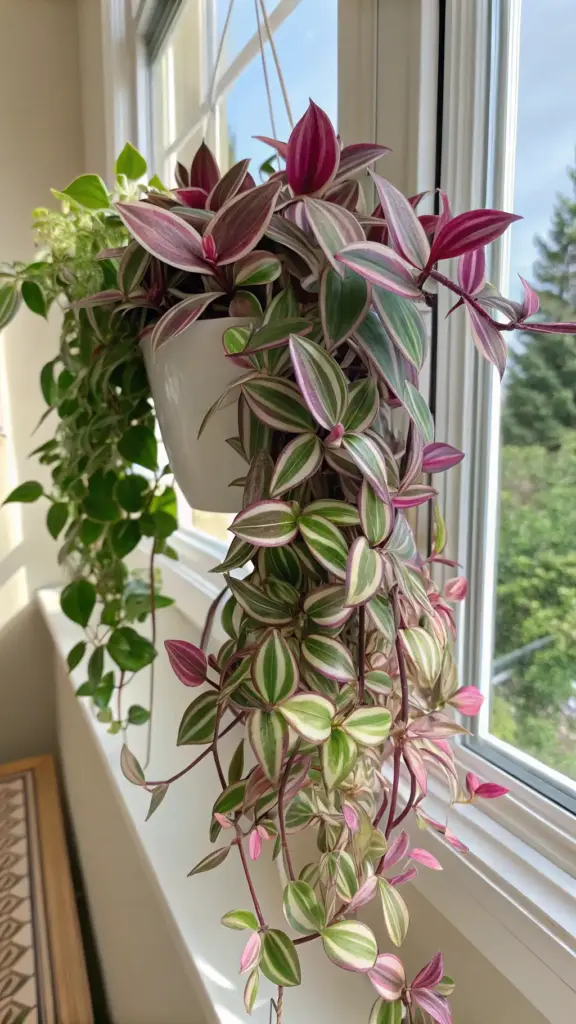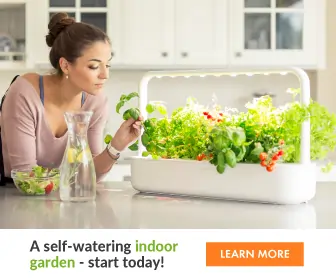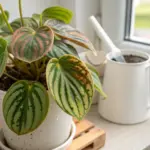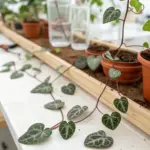6. Environmental Hacks for Year-Round Vibrancy

My Nanouk looked amazing in summer but turned into a sad, pale version of itself every winter. I was doing everything “right” with watering and fertilizing, but those gorgeous colors just disappeared for months.
That’s when I realized the environment around my plant was just as important as how I cared for it directly.
These environmental tweaks completely transformed my plant care game and kept my colors vibrant through every season.
Reflective Surface Magic That Doubles Your Light
Mirrors behind plants sound fancy, but I started with a simple$5 mirror from the dollar store. The difference was immediate and dramatic.
Placing a reflective surface about 12 inches behind my Nanouk basically doubled the light hitting the back leaves. Those previously hidden sections started developing incredible pink pigmentation.
White poster board works almost as well as mirrors and costs practically nothing. I tape it to the wall behind my plant shelf for instant light amplification.
Aluminum foil is my emergency reflector when I need to boost light quickly. It looks terrible but works amazingly well for color enhancement during dark winter months.
Microclimate Creation That Changes Everything
Humidity trays became my obsession after I realized how much dry air was dulling my colors. I use shallow saucers filled with pebbles and water under every plant.
Grouping plants together creates natural humidity through transpiration. My “plant corner” stays 15-20% more humid than the rest of my living room.
Strategic plant placement near my bathroom keeps humidity levels perfect. That steamy environment after showers mimics the tropical conditions Nanouk craves.
I use a small humidifier during winter heating season. Consistent 50-60% humidity keeps colors vibrant when everything else is working against me.
Air Circulation Secrets for Color Preservation
Stagnant air was slowly killing my colors without me realizing it. Plants need gentle air movement for proper gas exchange and nutrient processing.
A small oscillating fan positioned 6 feet away creates perfect air circulation without causing stress. Direct airflow actually damages those delicate variegated leaves.
Ceiling fans on low speed work beautifully for whole-room air movement. The gentle circulation prevents fungal issues that can dull colors.
Opening windows for cross-ventilation during mild weather gives plants that fresh air boost they need for optimal pigment production.
Seasonal Adjustments That Keep Colors Consistent
Winter environmental changes require completely different strategies. I move plants closer to windows and add supplemental lighting to combat shorter days.
Spring transition periods are tricky because of fluctuating temperatures and humidity. I gradually adjust environmental conditions rather than making sudden changes.
Summer heat management means creating shade and increasing humidity to prevent color bleaching from intense light and dry air.
Fall preparation involves slowly reducing environmental stimulation to help plants adjust to dormancy without shocking them.
Troubleshooting Color Loss Like a Pro
Sudden color fading usually means environmental stress rather than care issues. I check light levels, humidity, and air circulation before adjusting watering or fertilizing.
Gradual green dominance often indicates insufficient light reaching inner leaves. Reflective surfaces and plant rotation usually solve this problem.
Patchy color loss typically means uneven environmental conditions. Some leaves getting different light, humidity, or air circulation than others.
Seasonal color changes are normal, but dramatic shifts usually point to environmental factors that need adjustment.
Professional Display Techniques That Wow
Plant rotation every few days ensures all sides get equal light exposure. I mark my pots with tape so I remember which direction I last turned them.
Elevated positioning on plant stands gets trailing vines closer to light sources. Hanging planters work even better for maximum light exposure.
Backdrop selection matters more than I realized. Neutral colors make pink variegation pop, while busy backgrounds compete for attention.
Lighting angles can dramatically change how colors appear. I position grow lights at 45-degree angles for the most flattering illumination.
My Environmental Game-Changers
White walls reflect so much more light than I expected. Painting the wall behind my plant shelf increased ambient light levels significantly.
Strategic mirror placement turned my north-facing window into a surprisingly effective growing spot. Light reflection from multiple angles created perfect conditions.
Humidity monitoring with a digital hygrometer helped me understand how much environmental conditions fluctuate throughout the day.
Seasonal lighting adjustments using timers keep photoperiods consistent even when natural daylight changes dramatically.
Common Environmental Mistakes I Made
Placing plants too close to heating vents created hot, dry microclimates that bleached colors within weeks. Consistent environmental conditions work better than dramatic fluctuations.
Ignoring air circulation led to fungal issues that dulled leaf surfaces and reduced color vibrancy. Gentle airflow prevents so many problems.
Over-humidifying caused more problems than under-humidifying. Balanced humidity around 50-60% works better than extreme levels.
Forgetting about seasonal changes meant my environmental setup worked great in summer but failed miserably in winter.
Creating Instagram-Perfect Environments
Clean backgrounds make colors pop in photos. I use a simple white wall or neutral backdrop for the most dramatic color contrast.
Natural lighting from windows creates the most authentic-looking photos. Artificial lighting can wash out those subtle pink and purple tones.
Plant groupings photograph beautifully and create better growing conditions through increased humidity and light reflection.
Seasonal styling keeps my plant displays interesting year-round while maintaining optimal environmental conditions for color development.
The Ultimate Environmental Setup
My perfect Nanouk environment combines bright indirect light with reflective surfaces, 50-60% humidity from grouped plants and humidity trays, gentle air circulation from a distant fan, and seasonal adjustments for consistent conditions.
Temperature fluctuations between day and night, strategic positioning away from heating/cooling vents, and regular rotation for even light exposure complete the setup.
Monitoring tools like thermometers and hygrometers help me maintain these conditions consistently rather than guessing.
The result? Year-round color vibrancy that makes every plant parent jealous and keeps my Nanouk looking like it just came from the nursery.
Conclusion
Your Tradescantia Nanouk doesn’t have to be just another green houseplant! With these six professional plant care hacks, you’re now equipped with the insider knowledge to achieve those stunning pink, purple, and silver colors that make this plant such a showstopper. Remember, consistency is key – small daily adjustments will yield much better results than dramatic changes.
The best part? These techniques work beautifully whether you’re caring for plants in a cozy Chicago apartment or a sunny Los Angeles home. Your plant care journey is unique, and with patience and these proven methods, you’ll soon have a Tradescantia Nanouk that’s the envy of every plant parent in your circle.
Ready to transform your plant care game? Start with just one hack this week and watch the magic happen! Don’t forget to share your colorful results – I’d love to see how these professional techniques work in your space.









GIPHY App Key not set. Please check settings